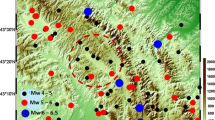Abstract
A high-resolution finite volume method approach to incorporating time-dependent slip across rectangular subfaults when modeling general fault geometry is presented. The fault slip is induced by a modification of the Riemann problem to the linear elasticity equations across cell interfaces aligned with the subfaults. This is illustrated in the context of the high-resolution wave-propagation algorithms that are implemented in the open source Clawpack software (www.clawpack.org), but this approach could be easily incorporated into other Riemann solver based numerical methods. Surface deformation results are obtained in both two and three dimensions and compared to those given by the steady-state, homogeneous half-space Okada solution.





Similar content being viewed by others
Notes
See www.clawpack.org/okada.html.
References
Berger, M.J., George, D.L., LeVeque, R.J., Mandli, K.T.: The GeoClaw software for depth-averaged flows with adaptive refinement. Adv. Water Res. 34, 1195–1206 (2011)
Clawpack Development Team: Clawpack Software. Version 5.3.1 (2014). doi:10.5281/zenodo.50982
Dutykh, D., Dias, F.: Tsunami generation by dynamic displacement of sea bed due to dip-slip faulting. Math. Comput. Simul. 80(4), 837–848 (2009). doi:10.1016/j.matcom.2009.08.036
Dutykh, D., Mitsotakis, D., Gardeil, X., Dias, F.: On the use of the finite fault solution for tsunami generation problems. Theor. Comput. Fluid Dyn. 27(1–2), 177–199 (2013). doi:10.1007/s00162-011-0252-8
Hartzell, S., Liu, P., Mendoza, C.: The 1994 Northridge, California, earthquake: Investigation of rupture velocity, risetime, and high-frequency radiation. J. Geophys. Res. Solid Earth 101(B9), 20091–20108 (1996). doi:10.1029/96JB01883
Ji, C., Wald, D.J., Helmberger, D.V.: Source description of the 1999 Hector Mine, California, earthquake, part I: wavelet domain inversion theory and resolution analysis. Bull. Seismol. Soc. Am. 92(4), 1192–1207 (2002). doi:10.1785/0120000916
Kozdon, J.E., Dunham, E.M.: Constraining shallow slip and tsunami excitation in megathrust ruptures using seismic and ocean acoustic waves recorded on ocean-bottom sensor networks. Earth. Planet. Sci. Lett. 396, 56–65 (2014). doi:10.1016/j.epsl.2014.04.001
Lemoine, G.I.: Three-dimensional mapped-grid finite volume modeling of poroelastic-fluid wave propagation. SIAM J. Sci. Comput. 38, B808–836 (2016). doi:10.1137/130934866
Lemoine, G.I., Ou, M.Y.: Finite volume modeling of poroelastic-fluid wave propagation with mapped grids. SIAM J. Sci. Comput. 36, B396–B426 (2014). doi:10.1137/130920824
Lemoine, G.I., Ou, M.Y., LeVeque, R.J.: High-resolution finite volume modeling of wave propagation in orthotropic poroelastic media. SIAM J. Sci. Comput. 35, B176–B206 (2013). doi:10.1137/120878720
LeVeque, R.J.: Finite Volume Methods for Hyperbolic Problems. Cambridge University Press, Cambridge (2002)
LeVeque, R.J., George, D.L., Berger, M.J.: Tsunami modeling with adaptively refined finite volume methods. Acta Numer. 20, 211–289 (2011)
Maeda, T., Furumura, T.: FDM simulation of seismic waves, ocean acoustic waves, and tsunamis based on tsunami-coupled equations of motion. Pure Appl. Geophys. 170, 109–127 (2011). doi:10.1007/s00024-011-0430-z
Maeda, T., Furumura, T., Noguchi, S., Takemura, S., Sakai, S., Shinohara, M., Iwai, K., Lee, S.J.: Seismic- and tsunami-wave propagation of the 2011 off the Pacific Coast of Tohoku earthquake as inferred from the tsunami-coupled finite-difference simulation. Bull. Seismol. Soc. Am. 103, 1456–1472 (2013). doi:10.1785/0120120118
Mandli, K.T., Ahmadia, A.J., Berger, M., Calhoun, D., George, D.L., Hadjimichael, Y., Ketcheson, D.I., Lemoine, G.I., LeVeque, R.J.: Clawpack: building an open source ecosystem for solving hyperbolic PDEs. PeerJ Comput. Sci. 2, e68 (2016). doi:10.7717/peerj-cs.68
Melgar, D., Bock, Y.: Kinematic earthquake source inversion and tsunami runup prediction with regional geophysical data. J. Geophys. Res. Solid Earth 120(5), 2014JB011832 (2015). doi:10.1002/2014JB011832
Nosov, M.A.: Tsunami waves of seismic origin: the modern state of knowledge. Izv. Atmos. Ocean. Phys. 50(5), 474–484 (2014). doi:10.1134/S0001433814030098
Okada, Y.: Surface deformation due to shear and tensile faults in a half-space. Bull. Seismol. Soc. Am. 75, 1135–1154 (1985)
Saito, T., Tsushima, H.: Synthesizing ocean bottom pressure records including seismic wave and tsunami contributions: toward realistic tests of monitoring systems. J. Geophys. Res. Solid Earth 121(11), 8175–8195 (2016). doi:10.1002/2016JB013195
Titov, V.V., Gonzalez, F.I., Bernard, E.N., Eble, M.C., Mofjeld, H.O., Newman, J.C., Venturato, A.J.: Real-time tsunami forecasting: challenges and solutions. Nat. Hazards 35(1), 35–41 (2005). doi:10.1007/s11069-004-2403-3
Vogl, C.J., LeVeque, R.J.: Code Archive (2017). doi:10.5281/zenodo.569351
Wilcock, W.S.D., Schmidt, D.A., Vidale, J.E., et al.: Sustained offshore geophysical monitoring in Cascadia. Whitepaper, The Subduction Zone Observatory Workshop, Boise (2016). http://faculty.washington.edu/rjl/pubs/SZOworkshop2016
Acknowledgements
The authors are grateful to Grady Lemoine for discussions of this work, in particular those involving the modification of the Riemann problems to incorporate fault slip.
Author information
Authors and Affiliations
Corresponding author
Additional information
Supported in part by the Gordon and Betty Moore Foundation and by NSF Grants DMS-1216732, DMS-1304081, and EAR-133141.
Rights and permissions
About this article
Cite this article
Vogl, C.J., LeVeque, R.J. A High-Resolution Finite Volume Seismic Model to Generate Seafloor Deformation for Tsunami Modeling. J Sci Comput 73, 1204–1215 (2017). https://doi.org/10.1007/s10915-017-0459-y
Received:
Revised:
Accepted:
Published:
Issue Date:
DOI: https://doi.org/10.1007/s10915-017-0459-y




